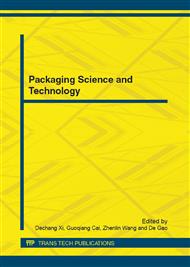p.305
p.312
p.316
p.321
p.325
p.331
p.335
p.339
p.343
Mechanical Performance and Microstructure of Plant Fiber Reinforced LDPE Foamed Composites
Abstract:
Plant fiber reinforced LDPE foamed composite was prepared with recycled corrugated paperboard, LDPE together with certain additives. The mechanical performances were tested and the effects of formula combinations on them were investigated. SEM was adopted to explore the effect of foaming agent on the microstructure of the composites. The results show that: 1) the tensile strength and bending strength increased while the notched impact strength and the elongation rate at break decreased with the plant fiber content. 2) The coupling agent LDPE-g-MAH could greatly improve the tensile strength and bending strength and the best mechanical performances were obtained at the coupling agent concentration of 5 wt% to that of plant fiber. 3) AC foaming agent brought down the density of the foamed composites, but the remerged cells became bigger and the tensile as well as bending strength declined with further over adding of AC. 4) the SEM observation showed a well-distributed cell size and more spherical cell shape as AC concentration going up within certain range.
Info:
Periodical:
Pages:
325-330
Citation:
Online since:
October 2012
Authors:
Keywords:
Price:
Сopyright:
© 2012 Trans Tech Publications Ltd. All Rights Reserved
Share:
Citation:


